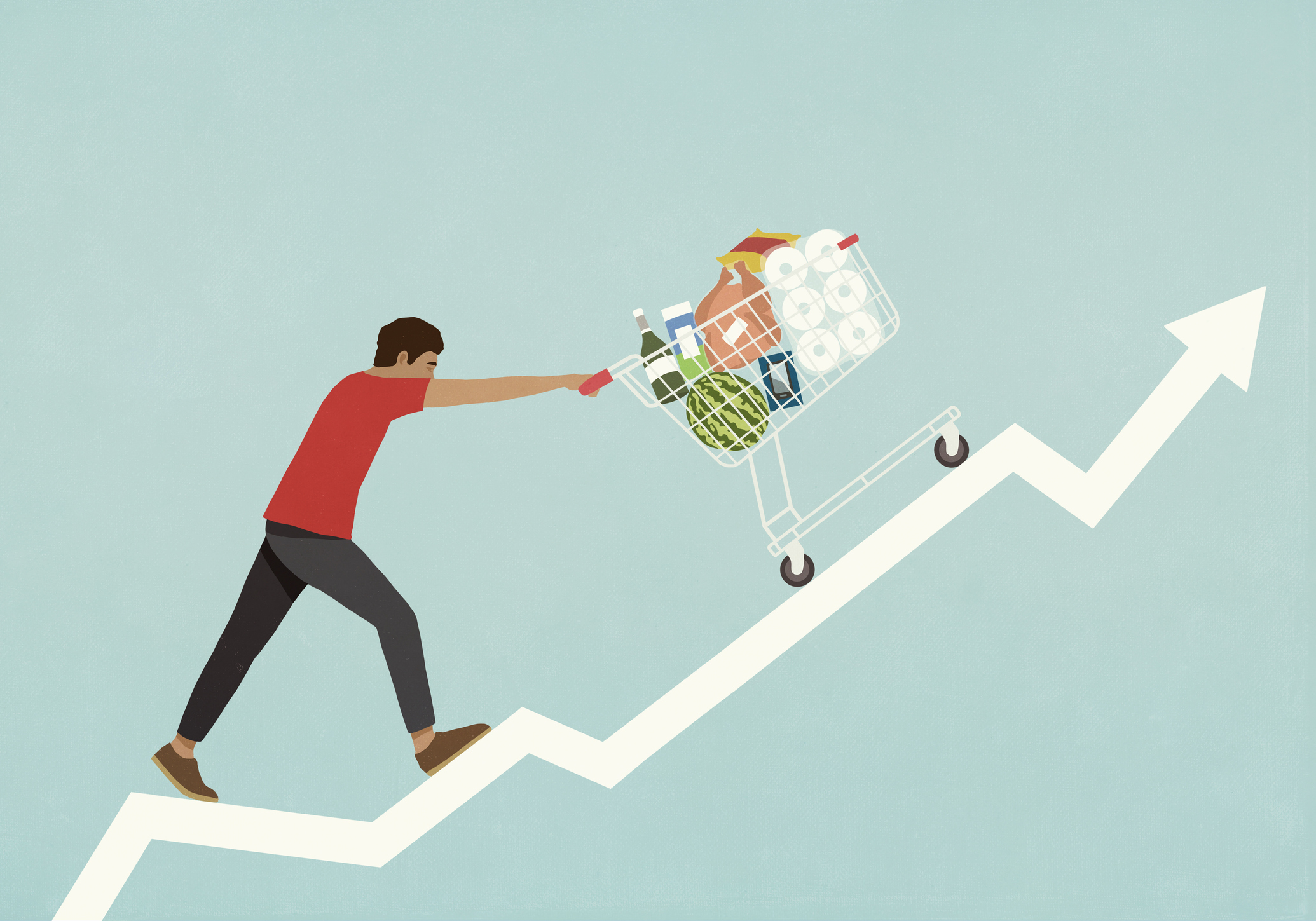Has The Inflation Genie Escaped The Bottle?
MSQ Capital’s Managing Director Paul Miron thinks a small recession could be the key to economic control.
OPINION
For the past 40 years, inflation in the western world has not triggered any emotion…until now. Naturally, the question we must ask is: What exactly has caused the sudden panic, fear, and obsession with the subject of inflation?
In central banks’ pursuit of taming inflation, we have seen the blunt instrument of raising interest rates being applied worldwide. This has negatively impacted most asset classes, especially property and shares.
Since 1990, the general trajectory of interest rates has been downward, ultimately reaching the floor of a 0.1% p.a. official cash rate in Australia. In other words, “free money”. This led to an unprecedented demand for almost any time type of asset that can store wealth.
It is no surprise that with the onset of rate hikes, as well as wild predictions of the share market and property market falling in excess of 60% and 30% respectively, all types of investors have their eyes and ears fixated on what will happen next in the global economy.
On the topic of interest rates, it must be noted that if rates are raised too quickly, they could trigger a recession. On the other hand, if inflation is unchecked this could lead to deeper and more damaging recessions worldwide. It may take decades to return to normality.
This is undoubtedly the most pressing economic issue of our time.
To understand the origins of inflation and to arrive at possible antidotes, one needs to dust off their economics textbooks from an era that experienced this phenomenon firsthand – the 70s.
As one of my favourite sayings goes – “History doesn’t repeat itself, but it often rhymes.”
What is the True Origin of Inflation?
Milton Friedman is one of the most highly regarded economists of modern times, reinforced by his receiving of the 1976 Nobel Memorial Prize in Economics for his work on the study of inflation. He is the principal architect of modern monetary policies applied by western central banks.
The words Friedman uttered during his era are all the more relevant to today’s economic climate. As he put so simply: “Inflation is a monetary phenomenon. It is made and stopped by central banks.”
In other words, it is the volume of money being printed, which can be economically summarised as an increase in the money supply, that is relevant to the question of inflation.
Increase In The Money Supply
Since the onset of COVID, the increase in money supply has never been more significant in our economic history. We have been paid a raft of various government benefits to sit at home and disrupt normal business and spending habits. At the same time, the RBA increased the money supply to counterbalance the loss of productivity. Central banks were essentially “printing more money” at a rapid pace, while lowering interest rates and allowing the bank to issue more credit.
Also, let us not forget quantitative easing, where the government buys and issues debt, reducing the cost of capital and creating massive liquidity in the financial markets.
According to Friedman, once a rapid increase in money supply occurs, it takes anywhere between 6 to 18 months for inflation to work through the economy. We are seeing this phenomenon firsthand here in Australia and around the world, with inflation rates not seen since the 70s.
Friedman also noted that inflation is not a global phenomenon but a home-grown problem that is caused by central banks and can be remedied by central banks.
Supply/Demand for Goods And Services
In the normal free-market economic system, prices of goods and services adjust according to demand, with businesses either increasing or decreasing production. Over time, this results in new business entrants increasing supply, or businesses leaving the market and decreasing supply.
Counterintuitively, these disruptions do not cause persistent inflation. From the onset of COVID, the stop-and-start nature of the global economy has resulted in supply chain issues and overnight demand for certain services, with employers needing to re-skill and re-tool their businesses to cope with unexpectedly high demand.
Once again, using free-market logic, these issues will eventually resolve themselves over time. Economists often refer to these impacts being ‘transitionary’ impacts of inflation; that is, temporary.
Looking back at the ’70s inflation crisis, many governments around the globe tried to lay blame on the 1973 war in the Middle East that disrupted oil production and increased its price by as much as 400%. Comparisons can be drawn to the Russian-Ukraine War and its effects to supply chains and commodities globally.
Despite this, the teachings of Milton Freidman tell us that these supply shocks provide short-term inflationary pressure. In the long-term, free-market economics will find a way to adjust the demand and supply of these goods.
Future Price Expectations
Perhaps the most ignored and least discussed aspect of inflation is future price expectations.
In the US, Australia and most western economies during the ‘60s, inflation had been unchecked for many years, rising from 1.5% to 5% during the ’60s, and reaching more than 14% in the ‘70s. In addition, wage inflation in Australia for the five years during 1969-1974 went up by 98%.
If businesses and employees are accustomed to long periods of persistent, rising inflation, a natural response to the rising cost of living will be employees demanding an adjustment to their wages, leading to higher prices and higher inflation. In such a situation, inflation becomes embedded in expectation and becomes a self-perpetuating inflationary issue that is commonly referred to as the ‘wage-price inflationary spiral’.
The main lesson to be learnt from the 70s is that we cannot allow unanchored inflation expectations. Central banks must act swiftly to tackle inflation and maintain the status quo of people having anchored expectations of inflation so as to maintain faith in our financial system. This is to avoid inflation becoming uncontrollable and inflicting unnecessary harsher pain to the economy.
This is precisely why despite Labor’s promises to support the market with 5.5% wage inflation, the RBA recommends that it remains capped at 3.5%. Lower wage inflation guards against a wage-price inflationary spiral.
Thus, we reach a conclusion that a short recession is better than losing control of inflation and letting loose future price expectations.
Looking back at our central bank, the current actions taken by the RBA are taken right out of pages in Milton Freidman’s economic textbook. They are acting swiftly and assertively.
We believe the next 6 months will have a heightened level of volatility in both the property and share market until there is evidence that the inflation beast has been tamed. We anticipate that this will only occur towards the end of the year once we receive data reflecting lower inflation.
Investors should expect a short and fast series of interest rate rises over the next four months.
Hopefully, this will be followed by stability with minimal changes to the official cash rate during 2023. This would enable the economy to re-adjust to the psychology of normalised interest rates.
The RBA Governor, Philip Lowe, indicated that an official rate of 2.5% is the correct setting for a neutral monetary policy and money supply. Investors and borrowers should brace for this setting sooner rather than later and prepare for the fact that we will have higher interest rates and softening asset prices.
Australia’s present economic strength is significant with a low base of unemployment, plentiful natural resources and a food-rich economy. Despite this, the sudden increase in interest rates will pose an additional risk. As mortgage managers, we appreciate our risk assessment and are completely cognisant to the downward risk of depreciating property prices.
We assess the risk of properties depreciating by perhaps between 15-20% – maybe even more for some specialised properties as well as regional properties and vacant land. Additionally, some construction projects have a significant risk of delays and cost blowouts that continue to be the predominant risk factor for this type of debt over the next 12 months.
However, with the lack of supply, wage inflation, migration, low levels of unemployment, rental growth and times of inflation, property is naturally seen as an inflation hedge. Thus, property will remain relatively resilient through these inflationary times.
—
Paul Miron has more than 20 years experience in banking and commercial finance. After rising to senior positions for various Big Four banks, he started his own financial services business in 2004.

This stylish family home combines a classic palette and finishes with a flexible floorplan
Just 55 minutes from Sydney, make this your creative getaway located in the majestic Hawkesbury region.
Continued stagflation and cost of living pressures are causing couples to think twice about starting a family, new data has revealed, with long term impacts expected
Australia is in the midst of a ‘baby recession’ with preliminary estimates showing the number of births in 2023 fell by more than four percent to the lowest level since 2006, according to KPMG. The consultancy firm says this reflects the impact of cost-of-living pressures on the feasibility of younger Australians starting a family.
KPMG estimates that 289,100 babies were born in 2023. This compares to 300,684 babies in 2022 and 309,996 in 2021, according to the Australian Bureau of Statistics (ABS). KPMG urban economist Terry Rawnsley said weak economic growth often leads to a reduced number of births. In 2023, ABS data shows gross domestic product (GDP) fell to 1.5 percent. Despite the population growing by 2.5 percent in 2023, GDP on a per capita basis went into negative territory, down one percent over the 12 months.
“Birth rates provide insight into long-term population growth as well as the current confidence of Australian families,” said Mr Rawnsley. “We haven’t seen such a sharp drop in births in Australia since the period of economic stagflation in the 1970s, which coincided with the initial widespread adoption of the contraceptive pill.”
Mr Rawnsley said many Australian couples delayed starting a family while the pandemic played out in 2020. The number of births fell from 305,832 in 2019 to 294,369 in 2020. Then in 2021, strong employment and vast amounts of stimulus money, along with high household savings due to lockdowns, gave couples better financial means to have a baby. This led to a rebound in births.
However, the re-opening of the global economy in 2022 led to soaring inflation. By the start of 2023, the Australian consumer price index (CPI) had risen to its highest level since 1990 at 7.8 percent per annum. By that stage, the Reserve Bank had already commenced an aggressive rate-hiking strategy to fight inflation and had raised the cash rate every month between May and December 2022.
Five more rate hikes during 2023 put further pressure on couples with mortgages and put the brakes on family formation. “This combination of the pandemic and rapid economic changes explains the spike and subsequent sharp decline in birth rates we have observed over the past four years,” Mr Rawnsley said.
The impact of high costs of living on couples’ decision to have a baby is highlighted in births data for the capital cities. KPMG estimates there were 60,860 births in Sydney in 2023, down 8.6 percent from 2019. There were 56,270 births in Melbourne, down 7.3 percent. In Perth, there were 25,020 births, down 6 percent, while in Brisbane there were 30,250 births, down 4.3 percent. Canberra was the only capital city where there was no fall in the number of births in 2023 compared to 2019.
“CPI growth in Canberra has been slightly subdued compared to that in other major cities, and the economic outlook has remained strong,” Mr Rawnsley said. “This means families have not been hurting as much as those in other capital cities, and in turn, we’ve seen a stabilisation of births in the ACT.”
This stylish family home combines a classic palette and finishes with a flexible floorplan
Just 55 minutes from Sydney, make this your creative getaway located in the majestic Hawkesbury region.


















